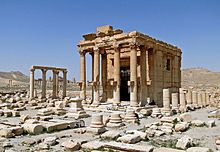User:Camocon/Beelshamen

Beelshamen (Baal-Shamin), also known as Shamayim "lord of the heavens", was a supreme deity and the sky god of pre-Islamic Palmyra in ancient Syria. His attributes are the eagle and the lightning bolt. "Beel" is one form of Baal, a Semitic title for "Lord", equivalent to Bel in Mesopotamia.
Beelshamen formed a triad with the lunar god Aglibol and the sun god Malakbel ("Messenger, or, Angel of the Lord").
History
[edit]The earliest known occurrence of the title Baal Shamin is in a treaty of the 14th century BC between Suppiluliumas I king of the Hittites and Niqmadu II, king of Ugarit. One might take this to be another name for Baal Hadad and again when the name appears in a Phoenician inscription by King Yeḥimilk of Byblos. But other texts make a distinction between the two.
In the treaty of 677 BC between King Esarhaddon of Assyria and King Ba‘al I of Tyre a curse is laid against King Baal if he breaks the treaty, reading in part:
May Baal-sameme, Baal-malage, and Baal-saphon raise an evil wind against your ships, to undo their moorings, tear out their mooring pole, may a strong wave sink them in the sea, a violent tide [. . .] against you.
The god Baal-malage is otherwise unexplained, Baal-saphon here and elsewhere seem to be Ba‘al Hadad whose home is on Mount Ṣaphon in the Ugaritic texts. But interpreters disagree as to whether theses are here three separate gods or three aspects of the same god, a god who causes stormy weather on the sea.
In any case inscriptions show the cult of Baal Shamin continued in Tyre from Esarhaddon's day until towards the end of the 1st millennium BC.
In Nabatean texts in Greek Baal Shamin is regularly equated with Zeus Helios, that Zeus as a sun-god. Sanchuniathon supports this:
... and that when droughts occurred, they stretched out their hands to heaven towards the sun; for him alone (he says) they regarded as god the lord of heaven, calling him Beelsamen, which is in the Phoenician language "lord of heaven," and in Greek "Zeus."
Unfortunately it is not clear whether Baal Shamin is here regarded both a sun-god and the bringer of rain or whether he is regarded as the cause of drought.
Writers in Syriac refer to Baal Shamin as Zeus Olympios.
At Palmyra a large temple to Baal Shamin has been excavated.
In Sanchuniathon's main mythology the god he calls in Greek Uranus 'Sky' has been thought by some to stand for Baal Shamin. Sky is here the actual father of Baal Hadad (though Baal Hadad is born after his mother's marriage to Dagon). As in Greek mythology and Hittite mythology Sky is castrated by his son who is in turn destined to be opposed by the thunder god. In Sanchuniathon's story Sky also battles Sea, and when Sky cannot prevail, he allies himself with Hadad.
Temple of Baal Shamin
[edit]
The "Temple of Baal Shamin" is an ancient stone ruin located in Palmyra, Syria. The temple, consecrated to the Semitic god Beelshamen (Baal Shamin), worshipped at Palmyra in triad with the lunar god Aglibol and the sun god Malakbel ("Messenger, or Angel, of the Lord"), formed the center of religious life in Palmyra and was dedicated in 32 AD.[1][2] Aedeen Cremin considers its ruins the "best preserved" at Palmyra.[3]
Palmyra (or Tadmor) is mentioned in the Hebrew Bible (Second Book of Chronicles 8:4) as a desert city built (or fortified) by the King Solomon of Judea:
There had been a temple at Palmyra for 2000 years before the Romans ever saw it. Its form, a large stone-walled chamber with columns outside, is much closer to the sort of thing attributed to Solomon (Sulayman) than to anything Roman. It is mentioned in the Bible as part of Solomon's Kingdom. In fact, it says he built it.
— Terry Jones and Alan Ereira, Terry Jones' Barbarians, p. 183
Flavius Josephus also attributes the founding of Tadmor to Solomon in his Antiquities of the Jews (Book VIII), along with the Greek name of Palmyra, although this must be a confusion with biblical "Tamara". Several citations in the tractates of the Talmud and of the Midrash also refer to the city in the Syrian desert (sometimes interchanging the letters "d" and "t" - "Tatmor" instead of "Tadmor").
External links
[edit]- Stuart Whatling: Arbia Syria: Palmyra (Some pictures of the temple of Ba‘al Shamîm at Palmyra.)
